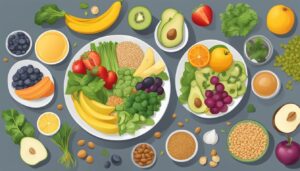Introduction
Comfort foods often evoke feelings of warmth and nostalgia, but they can also be laden with unhealthy ingredients. However, with a few simple swaps and creative twists, it’s possible to enjoy your favorite comfort foods in a healthier way. In this article, we’ll explore guilt-free recipes that offer the same comforting flavors you love, but with a nutritious twist to support your health and well-being.
Benefits of Healthy Comfort Foods
Maintaining Health Goals Without Sacrificing Taste
Healthy comfort foods offer a delightful compromise between satisfying cravings and maintaining health goals. Unlike traditional comfort foods, which are often high in calories, unhealthy fats, and refined sugars, these nutritious alternatives provide the same comforting flavors and textures without compromising on nutritional value. By choosing healthier ingredients and preparation methods, individuals can indulge in their favorite comfort foods guilt-free.
One of the primary benefits of healthy comfort foods is their ability to support weight management and overall well-being. By incorporating nutrient-rich ingredients such as whole grains, lean proteins, and plenty of vegetables, these dishes help to keep you feeling full and satisfied while providing essential vitamins, minerals, and antioxidants. This makes it easier to stick to your health goals without feeling deprived or restricted.
Incorporating Nutritious Ingredients for Added Benefits
One of the key advantages of healthy comfort foods is the opportunity to incorporate a wide range of nutritious ingredients that offer additional health benefits. From antioxidant-rich herbs and spices to fiber-packed vegetables and legumes, these ingredients not only enhance the flavor and texture of the dish but also provide essential nutrients that support overall health.
For instance, adding leafy greens like spinach or kale to a classic comfort food like macaroni and cheese increases the fiber content and adds vitamins A, C, and K. Similarly, using lean proteins such as chicken breast or tofu in place of fatty meats can reduce the saturated fat content while boosting protein intake.
Creating a Positive Relationship with Food
Healthy comfort foods play a crucial role in fostering a positive relationship with food by allowing individuals to enjoy their favorite dishes without feelings of guilt or deprivation. Unlike restrictive diets that focus on eliminating certain foods or food groups, healthy comfort foods emphasize balance, moderation, and mindfulness.
By savoring the flavors and textures of nutritious comfort foods, individuals can develop a deeper appreciation for the role that food plays in nourishing both the body and the soul. This can help reduce feelings of anxiety or guilt associated with eating and promote a more positive and sustainable approach to healthy eating habits.
Breakfast Recipes
Banana Oat Pancakes with Greek Yogurt and Berries
Start your day on a nutritious note with these delicious banana oat pancakes topped with creamy Greek yogurt and fresh berries. This breakfast recipe is not only easy to make but also packed with fiber, protein, and essential vitamins and minerals to fuel your morning.
To make these pancakes, simply blend ripe bananas, oats, eggs, and a touch of cinnamon in a blender until smooth. Then, heat a non-stick skillet over medium heat and pour the batter onto the skillet to form pancakes. Cook until golden brown on both sides, then serve topped with a dollop of Greek yogurt and a handful of fresh berries for a burst of flavor and added nutrition.
These banana oat pancakes are not only light and fluffy but also gluten-free and naturally sweetened, making them suitable for various dietary preferences. Plus, the addition of Greek yogurt provides a creamy texture and a boost of protein, while the berries add a pop of color and antioxidants to the dish.
Veggie-Packed Breakfast Burritos with Whole Wheat Tortillas
For a savory and satisfying breakfast option, try these veggie-packed breakfast burritos made with whole wheat tortillas. Loaded with nutritious ingredients like scrambled eggs, sautéed vegetables, and creamy avocado, these burritos are a perfect way to kickstart your day with a hearty and wholesome meal.
To make these breakfast burritos, start by sautéing your favorite vegetables such as bell peppers, onions, and spinach in a skillet until tender. In a separate pan, scramble some eggs until fluffy and cooked through. Then, assemble the burritos by layering the scrambled eggs, sautéed vegetables, sliced avocado, and a sprinkle of cheese onto whole wheat tortillas. Roll up the tortillas tightly, then heat them in a skillet until golden and crispy on the outside.

These veggie-packed breakfast burritos are not only delicious but also incredibly versatile. Feel free to customize them with your favorite veggies, herbs, and spices to suit your taste preferences. Plus, they can be made ahead of time and stored in the fridge or freezer for a quick and convenient breakfast option on busy mornings.
Lunch Recipes
Quinoa and Black Bean Stuffed Bell Peppers
Elevate your lunchtime with these flavorful quinoa and black bean stuffed bell peppers. Packed with protein, fiber, and essential nutrients, these stuffed peppers make for a satisfying and wholesome meal that will keep you energized throughout the day.
To make these stuffed bell peppers, start by cooking quinoa according to package instructions until fluffy. In a separate pan, sauté onions, garlic, diced tomatoes, black beans, corn, and your favorite spices until tender and fragrant. Then, mix the cooked quinoa with the black bean mixture and season to taste with salt, pepper, and any additional herbs or spices of your choice.
Next, slice the tops off of bell peppers and remove the seeds and membranes. Stuff each pepper with the quinoa and black bean mixture until full, then place them in a baking dish. Bake in the oven until the peppers are tender and the filling is heated through and slightly golden on top.
These quinoa and black bean stuffed bell peppers are not only delicious but also incredibly versatile. Feel free to customize the filling with your favorite vegetables, beans, and grains to suit your taste preferences. Plus, they can be made ahead of time and stored in the fridge for an easy grab-and-go lunch option during the week.
Turkey and Vegetable Soup with Whole Grain Bread
Warm up on a chilly day with a comforting bowl of turkey and vegetable soup served with whole grain bread. Packed with lean protein, fiber-rich vegetables, and whole grains, this hearty soup is a nutritious and satisfying option for lunch or dinner.
To make this turkey and vegetable soup, start by sautéing onions, carrots, celery, and garlic in a large pot until softened. Add diced turkey breast or leftover cooked turkey, along with low-sodium chicken broth, diced tomatoes, and your favorite herbs and spices. Let the soup simmer until the flavors meld together and the vegetables are tender.
Serve the turkey and vegetable soup hot with slices of whole grain bread for dipping. This soup is not only comforting and delicious but also incredibly nourishing, providing a balanced mix of protein, carbohydrates, and vitamins and minerals to keep you feeling full and satisfied.
Feel free to customize the soup with additional vegetables, beans, or grains to suit your taste preferences. Plus, it can be made in large batches and stored in the fridge or freezer for quick and convenient meals throughout the weeks.
FAQs
Q: What are healthy comfort foods?
A: Healthy comfort foods are dishes that offer the same comforting flavors and textures as traditional comfort foods but are made with nutritious ingredients and lower in calories, fat, and sugar.
Q: Why should I opt for guilt-free recipes?
A: Guilt-free recipes allow you to enjoy your favorite comfort foods without worrying about their impact on your health or waistline, promoting overall well-being and satisfaction.
Q: What are some examples of guilt-free comfort food ingredients?
A: Examples of guilt-free comfort food ingredients include whole grains, lean proteins, plenty of vegetables, healthy fats like avocado or olive oil, and natural sweeteners like honey or maple syrup.
Q: How can I make comfort foods healthier without sacrificing taste?
A: You can make comfort foods healthier by using healthier ingredients, such as swapping white flour for whole wheat flour, using Greek yogurt instead of sour cream, and adding more vegetables to dishes for extra nutrients and flavor.
Q: Can I still indulge in comfort foods while maintaining a healthy diet?
A: Yes, you can indulge in comfort foods by choosing healthier versions of your favorite recipes, practicing portion control, and balancing your meals with plenty of fruits, vegetables, and lean proteins.
Conclusion
Healthy comfort foods offer the best of both worlds—satisfying cravings while nourishing your body with wholesome ingredients. With the array of guilt-free recipes provided, you can indulge in your favorite comfort foods without compromising your health goals. So why not give these recipes a try and discover just how delicious and satisfying healthy eating can be? Whether you’re enjoying a bowl of turkey and vegetable soup or savoring a slice of cauliflower crust pizza, you’ll be treating yourself to wholesome, nourishing meals that leave you feeling satisfied and energized.



